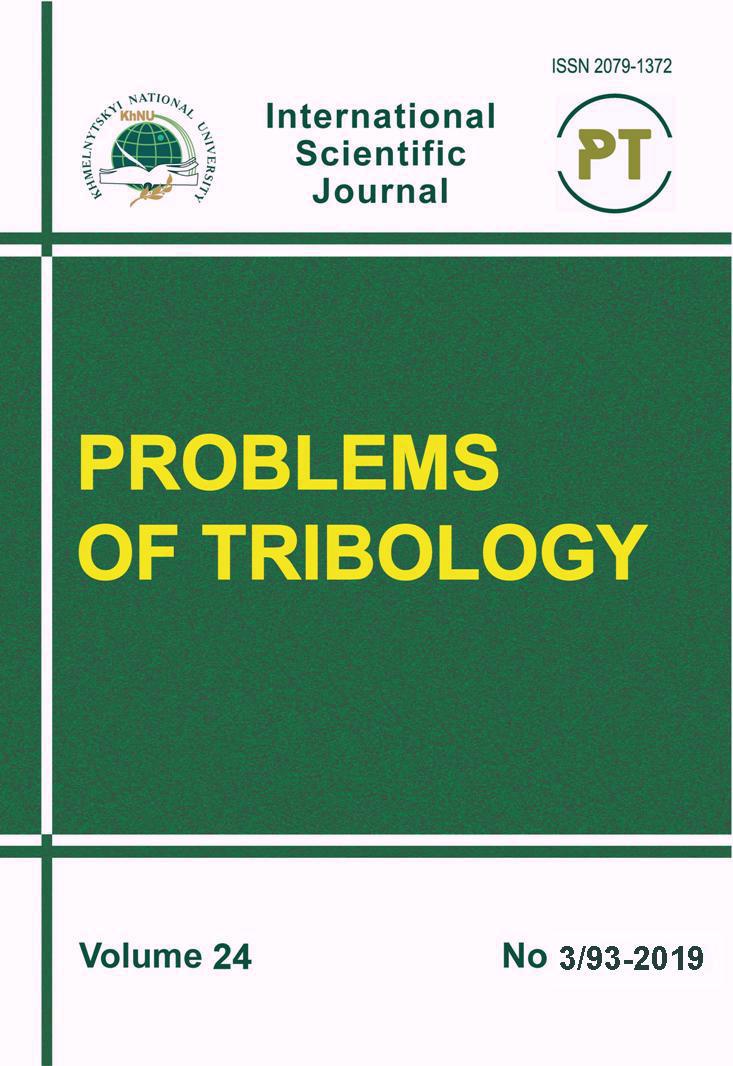Research of the contact and deformation properties of lubricated surfaces
DOI:
https://doi.org/10.31891/2079-1372-2019-93-3-62-67Keywords:
lubricated surface, indenter penetration, deformation, internal stresses, friction force, wear resistance.Abstract
The article considers the issues of contact interaction of steel surfaces under various contact conditions. To assess the depth of ball penetration, an experiment was conducted based on the indentation procedure on the Brinell press. The hypothesis of the formation of internal stresses under conditions of non-lubricated and contact in the presence of a lubricant is formulated. The effect of lubricant on the occurrence of resistance forces to the movement of the indenter in a special laboratory setup is investigated.
References
1. Bhushan, B. (2013). Introduction to Tribology. Second edition. New York: John Wiley & Sons, 721 p.
2. Dzhilavdari, I., Riznookaya, N. (2008). An experimental assessment of the components of rolling friction of balls at small cyclic displacements. Journal of Friction and Wear, 29(5), 330-338.
3. Dzhilavdari, I., Riznookaya, N. (2007). Specific features of the dynamics of small-amplitude pendulum swings in the presence of hysteresis friction. Friction and Wear, 28(2), 143–150.
4. Dzhilavdari, I., Riznookaya, N. (2008). Studies of the dynamics of free micro oscillations of a pendulum supported by two balls. Journal of Friction and Wear, 29(1), 1-8.
5. Kryshtopa, S., Kryshtopa, L., Bogatchuk, I., Prunko, I., Melnyk, V. (2017). Examining the effect of triboelectric phenomena on wear-friction properties of metal-polymeric frictional couples. Eastern-European Journal of Eenterprise Technologies, 1/5 (85), 40–45.
6. Dykha, A., Kuzmenko, A. (2003). Method of determining the coefficient of friction of lubricated surfaces. Problems of Tribology, 1, 136−139.
7. Dykha, A., Kuzmenko, A., Babak, J. (2011). Contact mechanics and wear of lubricated tribosystem. Khmelnitsky: KhNU, 250 p.
8. Sorokatyi, R. , Dykha A. (2015). Analysis of processes of tribodamages under the conditions of high-speed friction. Journal of Friction and Wear, 36 (5), 422–428.
9. Sherif, H.A., Almufadi, F.A. (2016). Identification of contact parameters from elastic-plastic impact of hard sphere and elastic half space. Wear, 368-369 (3), 358-367.
10. Lewis, S.R., Lewis, R., Olofsson, U. (2011). An alternative method for the assessment of railhead traction. Wear, 271 (1-2), 62-70.
11. Lewis, S.R., Lewis, R., Richards, P., Buckley-Johnstone, L.E. (2014). Investigation of the isolation and frictional properties of hydrophobic products on the rail head, when used to combat low adhesion. Wear, 314 (1-2), 213-219.
2. Dzhilavdari, I., Riznookaya, N. (2008). An experimental assessment of the components of rolling friction of balls at small cyclic displacements. Journal of Friction and Wear, 29(5), 330-338.
3. Dzhilavdari, I., Riznookaya, N. (2007). Specific features of the dynamics of small-amplitude pendulum swings in the presence of hysteresis friction. Friction and Wear, 28(2), 143–150.
4. Dzhilavdari, I., Riznookaya, N. (2008). Studies of the dynamics of free micro oscillations of a pendulum supported by two balls. Journal of Friction and Wear, 29(1), 1-8.
5. Kryshtopa, S., Kryshtopa, L., Bogatchuk, I., Prunko, I., Melnyk, V. (2017). Examining the effect of triboelectric phenomena on wear-friction properties of metal-polymeric frictional couples. Eastern-European Journal of Eenterprise Technologies, 1/5 (85), 40–45.
6. Dykha, A., Kuzmenko, A. (2003). Method of determining the coefficient of friction of lubricated surfaces. Problems of Tribology, 1, 136−139.
7. Dykha, A., Kuzmenko, A., Babak, J. (2011). Contact mechanics and wear of lubricated tribosystem. Khmelnitsky: KhNU, 250 p.
8. Sorokatyi, R. , Dykha A. (2015). Analysis of processes of tribodamages under the conditions of high-speed friction. Journal of Friction and Wear, 36 (5), 422–428.
9. Sherif, H.A., Almufadi, F.A. (2016). Identification of contact parameters from elastic-plastic impact of hard sphere and elastic half space. Wear, 368-369 (3), 358-367.
10. Lewis, S.R., Lewis, R., Olofsson, U. (2011). An alternative method for the assessment of railhead traction. Wear, 271 (1-2), 62-70.
11. Lewis, S.R., Lewis, R., Richards, P., Buckley-Johnstone, L.E. (2014). Investigation of the isolation and frictional properties of hydrophobic products on the rail head, when used to combat low adhesion. Wear, 314 (1-2), 213-219.
Downloads
Published
2019-10-23
How to Cite
Dykha, O., & Posonsky, S. (2019). Research of the contact and deformation properties of lubricated surfaces. Problems of Tribology, 24(3/93), 62–67. https://doi.org/10.31891/2079-1372-2019-93-3-62-67
Issue
Section
Articles






